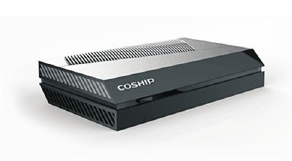
RECOMMENDED PRODUCTS
The main chip of N9201 product is up to 1GHz, the processing capacity is 2000DMIPS, and it fully complies with the DVB-C standard. It can integrate various mainstream CA systems such as Yongxin Tongfang, and support home network sharing, middleware, embedded browser and various two-way services. 2D graphics processing, rich multimedia applications.
Financial Knowledge Popularization Month丨Including "Department" Rate, Investment Helper in the Communication Industry
 Editor's note:
Editor's note:
To understand a listed company, you must be familiar with the industry environment in which the company operates. In order to help investors master the basic skills of financial analysis in different industries and improve their investment decision-making ability, the Investment Education Center of Shenzhen Stock Exchange, together with KPMG, Haitong Securities, Changjiang Securities, and Industrial Securities, jointly launched a series of investment education articles on “Industry from a Financial Perspective”. This article is the third article, which will take you to analyze the technological content of companies in the communication industry through R&D investment and goodwill. Let's take a look.
Including "section" rate, investment helper in the communication industry
The arrival of the 5G era, what does it mean? Emerging technologies such as artificial intelligence, Internet of Things, cloud computing, blockchain, and video social networking will develop rapidly relying on 5G. And this is the characteristic of the communication industry - the rapid iteration of technology and the scramble for research and development. With the front-end leading effect of the three major telecommunications companies and infrastructure suppliers such as Huawei and ZTE, companies in the downstream sub-sectors must form a technological advantage if they want to step on the rhythm. Understanding the "section" rate in corporate financial statements will help you find important references for investing in the communications industry.
1. How to look at R&D expenses
The communication industry is cyclical, and companies can only stay competitive in the industry by continuously investing in research and development. The R&D investment of the enterprise is generally included in the R&D expenses of the current income statement. Investors can understand the strength and trend of the company's independent R&D investment through the amount of R&D expenses and the ratio of R&D expenses to income, namely (current R&D expenses + current capitalized R&D expenses)/current income.
However, the reference role of R&D expenses alone is limited. For example, although the R&D expenses of some companies have increased considerably, and the vertical comparison of the R&D expense-to-income ratio with the company's situation over the years and the horizontal comparison of the industry have shown a positive trend, this result can only show that the company has invested more in R&D, and it does not fully reflect the Whether the company's R&D funds and time have yielded results, and whether it has stepped up to the pace of industry changes.
If you listen to one side, it will be dark; if you listen to both, you will be bright. Investors can also further analyze R&D expenses in conjunction with relevant non-financial metrics. For example, in the information disclosure of a listed company, the R&D expenses have been rising steadily over the years, the R&D team has continued to expand, and the R&D expense-to-income ratio has remained around 7%. However, after dividing the R&D expenditure by the number of R&D personnel, it will be found that the per capita R&D expenditure of the enterprise is only tens of thousands of yuan. This seems to be a little far from the "full" R&D expenses and "strong" R&D capabilities of the company created in the financial statements.
In addition, the balance sheet can also provide a certain reference for judging the company's "department" rate. For example, if a company is quite confident in the market benefits of its own research and development products, it will capitalize its research and development expenses, which will be reflected in the intangible assets of the balance sheet. However, including the telecommunications industry, many companies will be more cautious when choosing whether to capitalize due to the fierce competition and changing rhythm of the market in which they operate. Most new R&D patents and non-patented technologies are not capitalized and are not reflected in the financial statements as intangible assets. Therefore, investors cannot judge the value of patent rights and non-patented technologies owned by an enterprise solely based on the amount of intangible assets recorded in the financial statements, but also need to combine the analysis of changes in enterprise performance and other information disclosed to further explore the existence of “departments” in enterprises. rate, and judge the potential value brought to enterprises by newly acquired patent rights and non-patent technologies.
2. How to look at goodwill risk
In order to enhance their own scientific research capabilities and smooth out cyclical development fluctuations, companies in the communications industry will also choose to acquire companies from abroad. The acquisition of foreign companies can enable the company to obtain the scientific and technological achievements of the acquired company, thereby rapidly increasing the rate of "department". Generally speaking, when a company acquires, it holds good expectations for the acquisition target and is willing to pay a premium for future development, thus forming goodwill on the balance sheet. However, goodwill also has certain risks due to uncertainties about the future.
In order to protect the interests of investors, when most listed companies acquire, the acquired company generally makes a performance commitment and discloses the completion of the performance commitment. At this time, the performance of the performance commitment is like a transcript of the acquired company. When this report card "fails", it indicates that the follow-up operation of the acquisition did not meet the initial expectations, and investors need to pay attention to goodwill and its impairment risk.
However, when the "responses" handed over by listed companies year after year happen to be "passing marks", investors should be extra vigilant. For example, a listed company purchased a domestic first-class communication equipment company at a high premium, and the company made a performance commitment for the next three years, with after-tax profits of not less than 10 million yuan, 20 million yuan and 30 million yuan respectively. In the follow-up information disclosure, the after-tax profits of the acquired company reached 10.1 million yuan, 20.1 million yuan and 30.1 million yuan respectively, which can be described as "accurate compliance". In the first year after the performance commitment period expired, the after-tax profit of the acquired company plummeted to 10.3 million yuan, followed by impairment of goodwill and “change of face” in performance, which directly affected the profits of listed companies. For these clues, investors must pay attention.
The communication industry has high barriers to entry, obvious periodicity and prominent industry characteristics. In financial statements, in addition to focusing on R&D investment and goodwill, there are many more data that can be mined. This requires investors to continuously improve their investment capabilities, pay attention to the information required for investment decisions, accumulate knowledge necessary for investment decisions, and constantly correct irrational investment behaviors.
(This article is contributed by Zhu Xinnuo from KPMG Huazhen Accounting Firm)
(Disclaimer: This article is published for investor education purposes only and does not constitute investment advice. Investors operate on this basis at their own risk. Shenzhen Stock Exchange strives to ensure that the information contained in this article is accurate and reliable, but does not guarantee its accuracy or completeness. does not make any guarantees on the timeliness and timeliness, and is not responsible for the loss caused by the use of this article.)
Key words:







